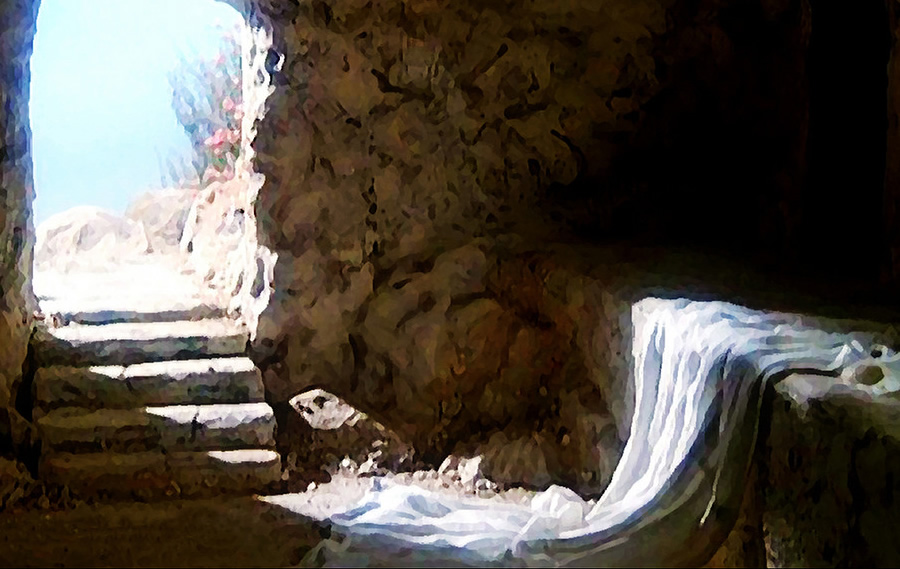
The Revelation of the Burial Cloths
04-09-2023Weekly Reflection© LPi Allison GingrasPeople want proof. Blind faith can be challenging, however, we know it is not only possible but actually a gift of great grace. One which, as Jesus tells the Apostle Thomas, blesses those who are able to believe without seeing (John 20:29). Yet, Jesus does wish us to see and believe and offers signs — moments that go beyond the miraculous to reveal something about who he truly is. There are seven signs in John’s Gospel. The Resurrection is the seventh. But where’s the proof? What can we see in today’s Gospel that offers irrefutable evidence as to Jesus’ resurrection versus an abduction of the body?
Let us focus on these two verses for our reflection, “When Simon Peter arrived after him, he went into the tomb and saw the burial cloths there, and the cloth that had covered his head, not with the burial cloths but rolled up in a separate place. Then the other disciple also went in, the one who had arrived at the tomb first, and he saw and believed” (John 20:6-8).
The Catechism of the Catholic Church (640) turns first our thoughts first to the empty tomb. “In itself it is not a direct proof of Resurrection; the absence of Christ’s body from the tomb could be explained otherwise. Nonetheless the empty tomb was still an essential sign for all.” Next, we focus on the burial cloths. In the Scriptures, when there is something important that demands special attention, it is often repeated. In John’s account of the Easter morning discoveries, we encounter the burial cloths, along with the words “saw and believed,” numerous times.
The Ignatius Catholic Study Bible: New Testament’s commentary on John 20:7, speaks of “the napkin (the linen cloths, aka burial cloths) as “Corroborating evidence of the Resurrection. No thief would have taken the time to unwrap Jesus' corpse and fold his burial clothes neatly in the tomb. In any case, the grave robbers of antiquity usually stole the expensive linens and left the body behind, not the other way around.”
The Gospel of John delves even deeper with their reflection on John 20:7.
“John’s description of the graveclothes suggests several important things about what happened to Jesus. The first, the presence of the burial cloths in the tomb refutes the speculation that Jesus’ body had been stolen, because grave robbers would not have unwrapped the corpse before stealing it. Second, the graveclothes point toward something unprecedented happening to Jesus through a contrast with the raising of Lazarus. When Jesus called Lazarus out of the tomb, Lazarus “came out, tied hand and foot with burial bands, and his face was wrapped in a cloth” (11:44), and Jesus then gave the order to unwrap him. But Jesus, who is not in the tomb, is not bound by the graveclothes or face cloth nor in need of anyone to untie him. Something radically different has happened to Jesus … Jesus’ resurrection is not resuscitation but God’s raising and transforming him to an immortal, glorified mode of existence …Third, the fact that the head covering was rolled up in a separate place suggests conscious, deliberate action. As Moloney points out, many verbs pertaining to what happened in the tomb, such as the stone being “removed” (20:1) and the face cloth being “rolled up” (20:7), are in the passive voice, which points to God as the agent. Jesus’ tomb is empty because God has directly acted here.”
Here's something minute but interesting to ponder regarding the way in which the burial cloths were left. Anyone who has lived with others, especially for three years, learns much about the manner in which they care for their belongings. Consider your college roommates or your own family, if you walked into the bathroom, would you know instantly who showered last by where (and how) you found their towel? Could we not then logically deduce, perhaps when Peter and John saw how the garment was arranged and left, they knew immediately who left it that way? Not to mention, how would a body — other than one risen from the dead — escape the cocoon-like wrappings of burial cloths hardened over the three days with about a hundred pounds of myrrh and aloes? Would a thief take the time to even remove the body from its wrappings or neatly roll the head covering?
We’ll conclude with these poignant words from John Bergsma (The Word of the Lord: Reflections on the Mass Readings for Solemnities and Feasts), “It still requires faith to say “Amen” to the radical assertion, “The Body of Christ.” And this is part of God’s pedagogy: He reveals Himself clearly enough that we have reason to believe, but not so directly as to compel us and force our will. He always leaves room for us to exercise faith because He desires children who will trust Him, not servants forced to serve Him. Let’s come as children to this Eucharist, confident in the testimony of the Apostles Peter (in the first reading) and John (in the Gospel) that Christ has risen, and exercising faith to believe the Eucharist we receive is the same Body that was missing from the tomb.”
As Pope St. John Paul II reminded us in a 1986 Angelus address, “We are an Easter People and Alleluia is our song! We are not looking for a shallow joy but rather a joy that comes from faith.” May you be blessed this Easter by believing without seeing, having recognized the greatest sign of why we can profess those words. The tomb is empty. Jesus is not dead, he is alive! Alleluia, Alleluia!
BACK TO LIST